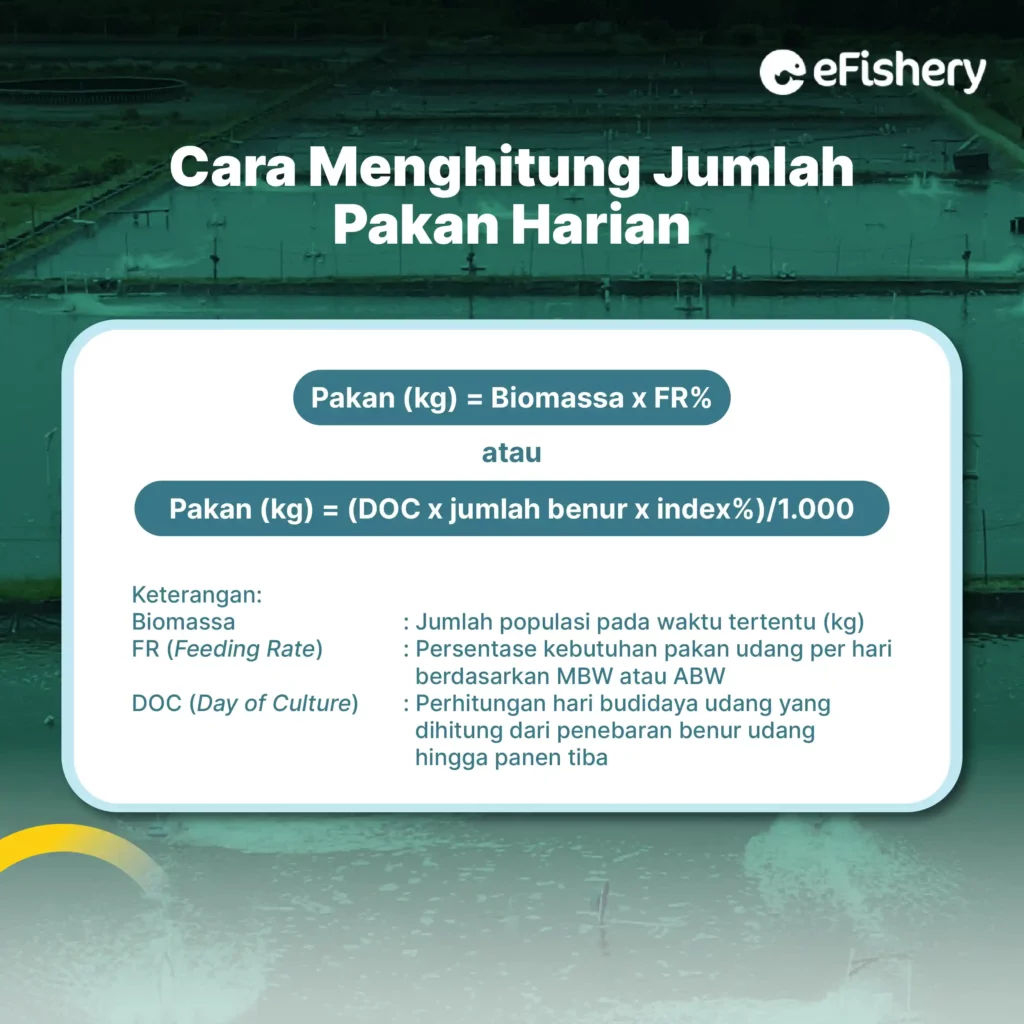Artikel Ini Telah Direview dan Berkolaborasi Dengan:

Sangga Sulistyo
Praktisi Aquaculture

Rifki Maulana
Tech Consultant IoT
The need for the number of eFeeders for shrimp ponds needs to be taken into account to optimize feed distribution. The need for the number of eFeeders (formerly known as eFishery Feeders) in each pond is different, depending on the area and stocking density of the shrimp.
The use of the right number of eFeeders aims to optimize the distribution of feed for shrimp so that the feed is spread evenly and no feed accumulates at one point. The hope is that all shrimp in the pond will receive relatively the same spread of feed and can grow to a uniform size.
Check out the following explanation to find out how to calculate the eFeeder needs in a shrimp pond!
Calculation of Shrimp eFeeder Needs

eFeeder from eFishery is auto feeder shrimp feed or automatic shrimp feed equipment to help farmers spread the feed. There are 3 factors that affect the amount of eFeeder needed for shrimp ponds, namely:
1. Number of fry
One eFeeder unit is capable of feeding 200,000 shrimp in one pond. If the number of fry is more than that, it is recommended to use more than 1 unit to optimize feeding for shrimp.
2. Pool area
Ideally, 1 unit of eFeeder is used for an area of 250-2,000 m22. The wider the pond pond, the more eFeeders are needed.
3. Feed Estimation from Initial Stocking to Harvest
You can calculate the estimated feed requirement based on the desired harvest target for 1 cycle. The greater the feed requirement, the more eFeeders needed. It is recommended to use more than 1 eFeeder unit to maximize feed distribution.
eFeeder is able to accommodate 70-75 kg of shrimp feed with a feed size of 1-5 mm and a feed ejection of 360 degrees. The eFeeder's ability to eject feed and the use of a wheel will help spread the feed evenly. When using an eFeeder, you only need to calculate the feed requirement in one day and do anco control every 2-3 hours so you can find out the shrimp's appetite. There are 2 ways to calculate the daily amount of feed, namely:

Positioning of the Shrimp eFeeder
There are some best practices or recommendations for placing eFeeders in shrimp ponds so they can function optimally. Check out the description below:
1. Placement of eFeeders using the Bridge Method (Bambang KS Farmers)

2. Placement of eFeeders using the Bridge Method (Farmers H. Supandi Brebes)

3. Placement of the eFeeder with the Bridge Method (Mr. Dilip Malingping)

Budidaya Udang Lebih Mudah dengan eFarm
Kini budidaya udang vaname akan jadi lebih mudah dengan eFishery. eFishery merupakan aplikasi andalan para petambak karena memiliki banyak fitur dan produk yang dapat mendukung keberhasilan budidaya udang Bapak/Ibu. Salah satunya adalah fitur Cultivation Consultation yang memberikan akses untuk berkonsultasi dan berdiskusi langsung dengan ahli budidaya.
Isi form di bawah dan downloads application eFarm untuk mendapatkan banyak manfaatnya!
Need Help Regarding Shrimp Cultivation Business?
Fill in your personal data in the following form. Our team will immediately contact you via the number cellphone attached. Make sure the data entered is correct.

Rifki Maulana - Tech Consultant IoT
Rifki menjadi bagian dari Tech Consultant Product IoT eFishery yang bertanggung jawab menganalisis kesiapan dan kerusakan produk IoT, seperti eFeeder

Sangga Sulistyo - Praktisi Aquaculture
Sangga adalah praktisi Aquaculture yang memulai karirnya pada tahun 2003 dan sekarang menjadi Technical Support Manager eFishery untuk seluruh wilayah Indonesia
Questions Regarding the Need for the Number of eFeeders
The number of eFeeders depends on the needs and conditions of the pond. Farmers can calculate eFeeder needs based on 3 factors, namely jthe number of fry, pond area, and estimated feed from initial stocking to harvest.
eFeeders can be placed at various points, depending on the number of eFeeders used and the size of the pond. Most importantly, Farmers must pay attention to several things, viz the distance of the bridge from the side of the pond, the distance of the bridge from the side of the pond length, the ejection of the feed, the distance of the anco to the eFeeder, and the distance of the eFeeder to the water.
